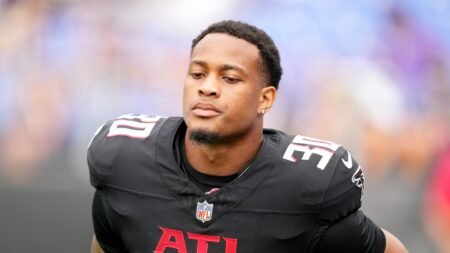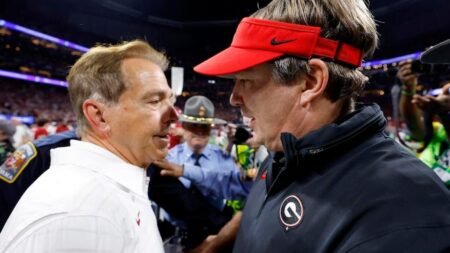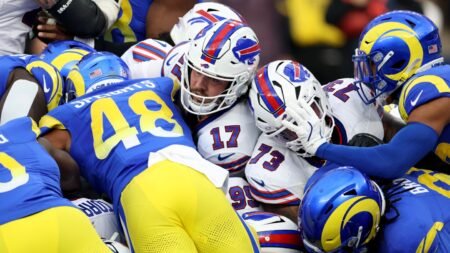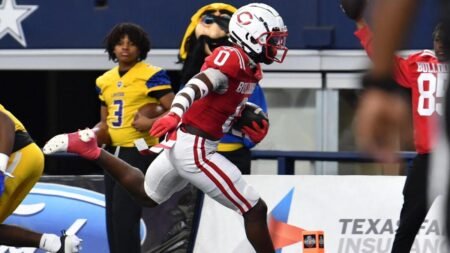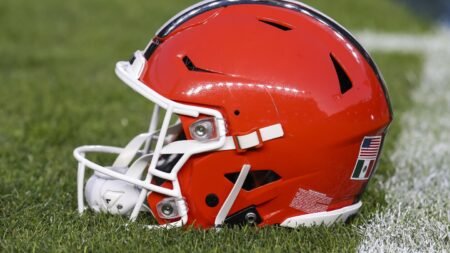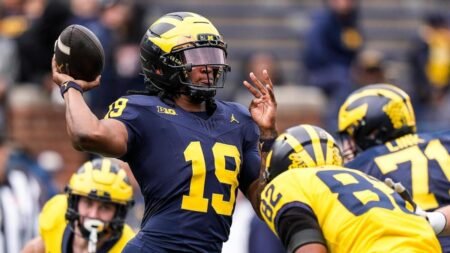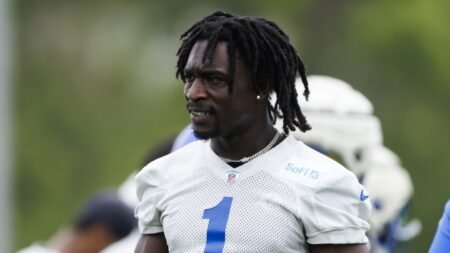Raheem Morris’ first year was funny, but not ha-ha funny, as the Falcons continued a culture of underachieving by missing the playoffs on the final day of the season. 2025 brings a renewed focus on getting it done, with a big win-now push led by dealing away their 2026 first-round pick. Fortunately for this article’s purview (fantasy football), we essentially just get to talk about 2024 because this team made almost no changes on offense.
Atlanta Falcons 2024 Stats (RANK)
Points per game: 22.9 (13th)
Total yards per game: 369.8 (6th)
Plays per game: 63.9 (8th)
Dropbacks per game: 37.8 (22nd)
Dropback EPA per play: 0.08 (16th)
Rush attempts per game: 29.1 (8th)
Rush EPA per play: -0.02 (7th)
Changing and staying the same with Raheem Morris
What can we say about the Atlanta Falcons that could be any worse for their fans than the truth? Morris looked downright unprepared to call timeouts when winning just one of their final two games likely would have been enough for Atlanta to make the postseason. Their new defensive coordinator, Jeff Ulbrich, spent the offseason being outheadlined by his son prank calling Shedeur Sanders. Since hiring Arthur Smith, the team has routinely failed to even disclose injuries – sometimes to the point of fines – and so we get tidbits like Kyle Pitts having his knee drained weekly dropped in notes columns two years later. Kirk Cousins is still here because the Falcons are treating his market like it’s 2021, and if he remains on the roster into any kind of Michael Penix Jr. slump it’s going to create an ocean of speculation that … well, is a lot like what happened last season, actually.
The Falcons are operating on a win-now timeline, trading their 2026 first-round pick as part of a move up for James Pearce in the first round of the draft. One thing about that is: They invested so heavily on defensive upgrades that they simply had no room to change the offense. Zac Robinson’s offense received exactly one draft pick: seventh-round tackle Jack Nelson, who will likely be fighting for a roster spot. The only skill position free agent they signed with a real chance to make the roster, barring major injuries, is wideout/punt returner Jamal Agnew.
In their wildest dreams, the Falcons want to become the Lions. They want to major in running the football, play good and aggressive defense, and throw when necessary and off play-action. The only problem is they finished 29th in defensive DVOA, didn’t really add a franchise-caliber free agent on defense, and arguably lost veteran talent there in shedding Justin Simmons and Grady Jarrett. Meanwhile they need to avoid regression on offense with almost no new pieces and, oh yeah, their starting quarterback is essentially a rookie. Perhaps it will work out – I don’t want to be obstinate for the sake of being obstinate – but it sure seems like the Falcons have put themselves into a position where it needs to work out. Never a great feeling when you’re relying on so many question marks that all need to go right.
Why Cousins not being at OTAs is good for Falcons
Given Kirk Cousins is not present for the start of the Falcons’ OTAs, Mike Florio and Chris Simms spell out why this is best-case scenario for Atlanta and spell out why the QB has limited options from here.
Passing game
QB: Michael Penix Jr., Kirk Cousins
WR: Drake London, Khadarel Hodge
WR: Darnell Mooney, Casey Washington
WR: Ray-Ray McCloud III, Chris Blair
TE: Kyle Pitts, Charlie Woerner
Unfortunately, we don’t have a huge sample size of Penix games to talk about from last season, as he started only three games and was successfully hidden in his debut against a Giants team that knew it was drawing dead. Statistically Penix was an upgrade on Kirk Cousins, notching +0.11 EPA per dropback to Cousins’ -0.01. That comes with caveats: Penix’s completion percentage over expected of minus-5.3 percent was well behind Cousins, and Penix was picked three times in three starts. That doesn’t sound bad, but given how careful NFL offense has become, it is essentially a league-leading pace. (Baker Mayfield and Cousins tied for the NFL lead with 16 picks last year.) Three games like that doesn’t mean much, but also … well, what does mean much when you play three games?
On paper everything is aligned for Penix to have a good season. The supporting cast is good enough, and the run game will keep opponents from keying on the rookie. He’s best treated as an eye-of-the-beholder low-end QB2. I’ll be watching him more carefully than most quarterbacks in training camp and preseason because my prior is simply “I don’t think most NFL teams saw him as a potential franchise quarterback” and I like to make sure my weaker-feeling priors get as much exposure as possible to chances to be wrong. The ceiling here feels more low-end QB1 than stratospheric. Penix only ran seven times in three games, a number that puts him more in the Bryce Young zone – mobile, runs bootlegs, but rarely takes off – than in a fantasy-interesting place.
Even with Penix in, Drake London continued to get his. The third-year receiver broke out with a 100/1271/9 line last year, hitting career highs in each category. That includes a 22/352/2 finish in three games with Penix, though it’s worth noting that 187/2 of that was against the Panthers’ similarly horrid defense in Week 18. London should be able to remain on the low-end WR1 line as the clear top target in this offense in 2025.
The big surprise of last year was Darnell Mooney, who bounced back from two years in Bears wilderness to put up a 65/992/5 line and could have easily topped 1,000 yards had he been active in Week 18. Mooney probably fits the brief as a fantasy WR3 this year as the clear No. 2 target in this offense, but there are reasons for a buyer to beware. He’s missed games in each of the last three seasons, and while he was held out of only Week 17 last year, he appeared on the injury report with four separate listings in 2024. When you compare the solidness of Mooney with the more-ceiling oriented picks on the WR3 line, I find myself heading more towards the ceiling. Not to say that Mooney can’t get there, just there are some yellow flags on his resume.
Kyle Pitts is heading into a rare post-post-post-hype sleeper year by not showing for OTAs with a strained foot muscle. Simply put: He hasn’t been 2021 Kyle Pitts since 2021. We can understand a late stab on him as a low-end TE1 because the talent makes it obvious that he should be better than this, but nothing we’ve seen the last three years would lead us to believe he’ll do more than have a spike week here or there.
McCloud had his most impressive offensive season to date but is more of a PPR-scam-in-bye-weeks receiver than someone you’re really excited to roster. Hodge is the clear first man up in case of injuries at wideout. He’s an aspiring Mack Hollins-type, a big-bodied blocker who offers something downfield. Hodge could be interesting in a firm role but doesn’t offer some sort of sky-high ceiling. Woerner is a blocker.
Falcons expect Pitts to ‘take a big jump’ in 2025
Atlanta Falcons offensive coordinator Zac Robinson expects to see Kyle Pitts “take a big jump” in 2025, and Lawrence Jackson Jr. explains how you should approach the fifth-year tight end in fantasy drafts this season.
Running Game
RB: Bijan Robinson, Tyler Allgeier, Jase McClellan
OL (L-R): Jake Matthews, Matthew Bergeron, Ryan Neuzil, Chris Lindstrom, Kaleb McGary
After a smaller workload than expected in his first season, Bijan Robinson quickly became one of the best backs in the NFL in 2024. He touched the ball 365 times, second in the league to only Saquon Barkley, and scored 15 times. Robinson was seventh in the NFL in rushing yards over expected, and was first among all running backs in success rate. The pedigree, direction of the offense, and talent all point to this continuing in 2025. Sorry, Denny.
This left the Tyler Allgeier memorial Thorn In Our Side Role mostly empty in 2024. Allgeier had five games with more than 10 carries, so it wasn’t like he went completely unused, but he went over 30 percent of the snaps just four times in 17 games. It’s a role that leans more towards him being a touchdown-or-bust FLEX than anything substantial, though of course he maintains sizeable value as a Robinson injury hedge. Allgeier would belong in the RB1 conversation if anything happened to Robinson. Jase McClellan received just 19 snaps in his rookie season and would probably need chaos in front of him to see a fantasy-relevant role in 2025.
The offensive line returns mostly intact from 2024. The only real injury they dealt with last year was Drew Dalman’s high-ankle sprain, and running Neuzil out there as his replacement gave them enough confidence to go with Neuzil as the starter in 2025.
Matthews is getting up there – he’ll participate in his 12,000th-NFL snap in the first game of the season. But Lindstrom has been a PFF Darling for some time and both Bergeron and McGary are above-average run blockers who should keep the line from suffering any kind of major dropoff that would hurt the running game.
Falcons running back Bijan Robinson has identified an area he’d like to improve in during the 2025 season.
Atlanta Falcons 2025 win total
The over/under was set at 7.5 wins at DraftKings, but with a minus-140 on the over that clearly forecasts a belief that they’ll be a bit better. I think there are enough scenarios where things come together for the Falcons to be hesitant to bet the under, but I’m also not wild about tying up money for months on a minus-140 line to go over. If you forced me to bet something Falcons-related, I’d probably go with the plus-155 on making the playoffs altogether.
Read the full article here






